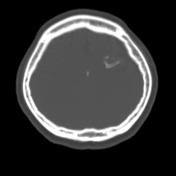Presentation
Female in 30's presents to A and E following a seizure.
Patient Data





Gyriform calcification in the high left frontal lobe, with the characteristic 'tram-track' calcification.
Associated parenchyma volume loss.
Disproportionately large left frontal sinus compared to the right.
Choriod plexus symmeterical.
Case Discussion
Sturge Weber syndrome is one form of phakamatosis, characterized by a pial hemangioma in the brain with an associated facial hemangioma.
The leptomeningeal hemangioma results in a vascular steal affecting the subjacent cortex and white matter producing localized ischemia, hence the associated parenchymal volume loss.




 Unable to process the form. Check for errors and try again.
Unable to process the form. Check for errors and try again.